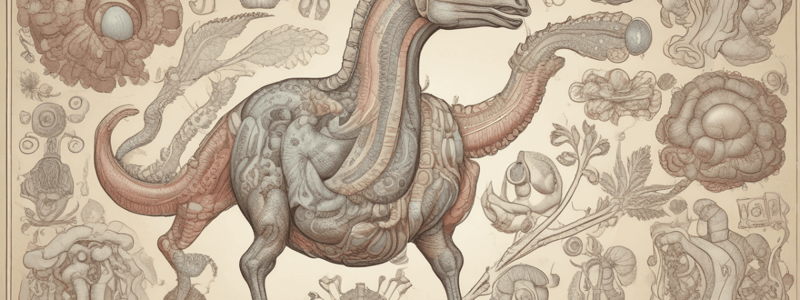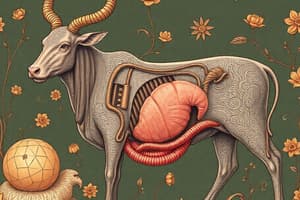Podcast
Questions and Answers
What is the primary role of microorganisms in the ruminant digestive system?
What is the primary role of microorganisms in the ruminant digestive system?
- To break down cellulose in plant cell walls (correct)
- To absorb nutrients from the bloodstream
- To synthesize proteins from amino acids
- To secrete digestive enzymes into the stomach
What is the main difference between a ruminant and a monogastric digestive system?
What is the main difference between a ruminant and a monogastric digestive system?
- The type of teeth present in the animal's mouth
- The absence of microorganisms in the gut
- The presence of four chambers in the stomach (correct)
- The number of stomachs present in the animal
Which of the following animals is an example of a monogastric organism?
Which of the following animals is an example of a monogastric organism?
- Pig
- Cow
- Human (correct)
- Goat
What is the correct pathway of food travel in a monogastric animal?
What is the correct pathway of food travel in a monogastric animal?
What is the function of the rumen in a ruminant animal?
What is the function of the rumen in a ruminant animal?
Flashcards are hidden until you start studying
Study Notes
Digestive Systems
- Ruminant and monogastric digestive systems can be compared and contrasted
- Key difference: ruminant digestive system involves microorganisms, whereas monogastric does not
Characteristics of Digestive Systems
- Ruminant digestive system:
- Has four chambers: rumen, reticulum, omasum, and abomasum
- Each chamber has a specific function
- Monogastric digestive system:
- Has one stomach chamber
- No involvement of microorganisms
Types of Animals and Their Digestive Systems
- Ruminant animals: cows, sheep, goats, deer
- Monogastric animals: humans, dogs, cats, pigs
Teeth and Their Functions
- Different types of teeth: incisors, canines, premolars, molars
- Each type of tooth has a specific function in the digestion process
Food Pathway in Monogastric Animals
- Food enters the mouth, where it is chewed and mixed with saliva
- Food then passes through the esophagus into the stomach
- In the stomach, food is mixed with digestive enzymes and acids
- Food then enters the small intestine, where nutrients are absorbed
- Finally, waste products enter the large intestine and are eliminated
Role of Microorganisms in Ruminant Digestive System
- Microorganisms break down cellulose in plant cell walls
- Microorganisms produce volatile fatty acids, which provide energy to the animal
- Microorganisms also produce proteins and vitamins essential for the animal's growth and health
Studying That Suits You
Use AI to generate personalized quizzes and flashcards to suit your learning preferences.




